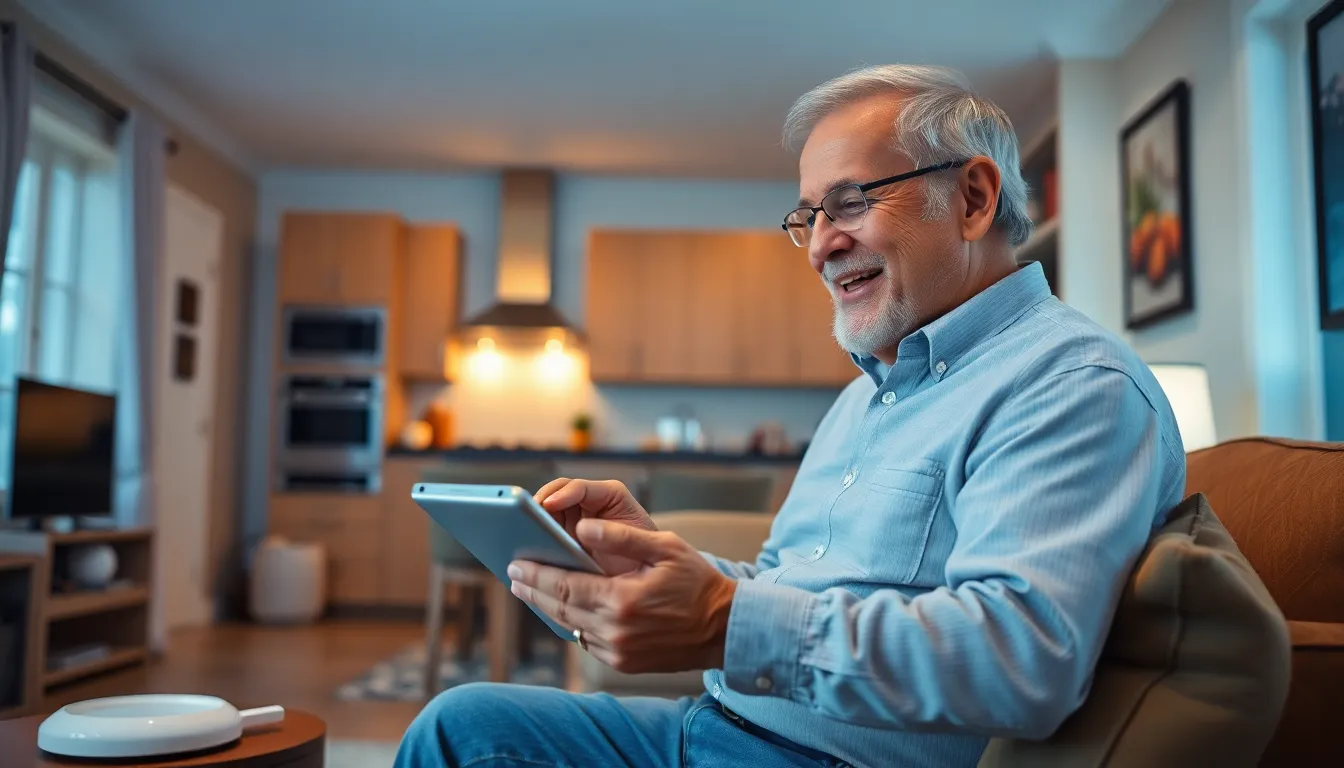Table of Contents
ToggleAs technology zooms ahead at lightning speed, it’s easy to think that smart home devices are just for the tech-savvy millennials. But hold on! Seniors can benefit just as much from these nifty gadgets, turning their homes into comfortable, efficient, and safe havens. Imagine a world where the lights turn on with a simple voice command or where the thermostat adjusts itself without a second thought. Sounds like magic, right?
Overview of Smart Home Devices for Seniors
Smart home devices offer significant benefits to seniors, promoting independence and enhancing overall quality of life. Voice-controlled assistants simplify daily tasks, allowing seniors to control lights, thermostats, and entertainment systems effortlessly. These devices respond to simple commands, minimizing the need for physical effort and navigating complexities.
Smart security systems contribute to home safety with features like smart doorbells and cameras, which enable remote monitoring. Seniors receive notifications through smartphones or tablets, empowering them to stay informed about their surroundings, even when away from home. Smart locks offer ease of access without the struggle of traditional keys.
Smart appliances play a crucial role in home management, too. Refrigerators with built-in cameras help seniors track food inventory, reducing waste. Smart ovens allow for remote cooking adjustments, ensuring meals are ready when required.
Health and wellness devices further enhance the security and well-being of seniors. Wearable health trackers monitor vital signs and activity levels, providing valuable data for caregivers. Medication management systems alert seniors when it’s time to take medications, reducing the chances of missed doses.
In addition, home monitoring solutions enable caregivers to monitor their loved ones’ daily activities. These systems detect irregular patterns such as changes in movement or sleeping habits, allowing families to respond promptly if concerns arise.
Integrating smart home devices into seniors’ lifestyles can significantly elevate comfort, ensuring a safer living environment. Adopting these technologies fosters a sense of empowerment, enabling seniors to maintain their independence while receiving the necessary support.
Benefits of Smart Home Devices

Smart home devices offer numerous advantages for seniors. These technologies significantly enhance safety, convenience, and overall quality of life.
Enhanced Safety Features
Enhanced safety features stand out as one of the most important aspects of smart home devices. Smart security systems, including cameras and doorbells, provide real-time monitoring, allowing seniors to check who’s at the door without going outside. Geofencing technology can alert family or caregivers if a senior leaves a designated area without notice. Furthermore, automated lighting systems reduce fall risks by illuminating pathways during nighttime hours. Smart smoke detectors send alerts to smartphones, ensuring timely evacuation in emergencies. Each of these features contributes to a safer living environment, reinforcing peace of mind for seniors and their loved ones.
Improved Convenience
Improved convenience is another key benefit of smart home technologies. Voice-activated assistants streamline daily tasks, from setting reminders to controlling home systems. Smart thermostats automatically adjust temperatures, helping seniors maintain comfort without manual intervention. Smart appliances, such as refrigerators with internal cameras, make grocery management easier by allowing seniors to view contents remotely. Automation of routine chores frees up time for more enjoyable activities. Health monitors can track vital signs and share data with healthcare providers, simplifying wellness management. By integrating these user-friendly devices, seniors enjoy a more convenient and manageable lifestyle.
Types of Smart Home Devices
Smart home devices enhance safety, convenience, and independence for seniors. Various types of devices cater to different needs and preferences.
Smart Security Systems
Smart security systems offer peace of mind for seniors and their families. These systems include doorbell cameras and motion sensors that allow for real-time monitoring. Remote access enables seniors to check who is at the door without physically getting up. Alerts sent directly to smartphones help caregivers stay informed about unusual activity. Surveillance cameras, strategically placed outdoors, enhance safety around the property.
Voice-Activated Assistants
Voice-activated assistants make daily tasks easier for seniors. These devices respond to simple voice commands, enabling hands-free operation of various functions. Seniors can control smart home devices, ask questions, or set reminders effortlessly. Examples include Amazon Echo and Google Home, which integrate with other smart devices for seamless management. The ability to make phone calls or send messages with just a voice command adds a layer of convenience.
Smart Lighting Solutions
Smart lighting solutions provide customizable lighting for different needs. Seniors can adjust brightness levels or colors using mobile apps or voice commands. Automatic timers ensure that lights turn on or off according to daily routines, enhancing safety. Motion-activated lights illuminate dark areas, reducing the risk of falls. The ability to create lighting scenes can also help with relaxation or alertness, depending on the time of day.
Health Monitoring Devices
Health monitoring devices play a crucial role in supporting seniors’ well-being. Wearable trackers monitor vital signs, including heart rate and activity levels, enabling proactive health management. Medication management systems remind seniors when to take their medications, promoting adherence. Some devices connect directly to healthcare providers, allowing for continuous health monitoring. Emergency alert systems ensure timely assistance in case of a fall or medical emergency.
Tips for Choosing Smart Home Devices
Choosing the right smart home devices enhances convenience and safety for seniors. Prioritizing specific features ensures maximum benefits.
Consider User-Friendliness
User-friendliness simplifies the interaction with smart devices. Look for gadgets that require minimal setup and offer intuitive interfaces. Voice-controlled options, for instance, enable seniors to operate devices hands-free. Devices with large buttons and clear displays improve usability. Additionally, consider options that have straightforward mobile applications. Avoid complex features that may cause confusion. Read reviews to gauge ease of use from other seniors’ perspectives. An important factor is customer support availability, which can assist during setup or troubleshooting.
Compatibility with Existing Systems
Compatibility with existing systems prevents additional expenses and complications. Check if new devices can integrate easily with current technology, such as smartphones or voice assistants. Ensure compatibility with operating systems like iOS or Android, as this affects usability. Investigate if the devices work seamlessly with home networks. A unified platform simplifies operations, allowing seniors to manage multiple devices from one application. Selecting devices that communicate effectively enhances overall functionality. Compatibility reduces frustration and fosters a smoother user experience for seniors, supporting their independence at home.
Smart home devices offer invaluable support for seniors seeking to enhance their daily lives. By providing convenience safety and independence these technologies empower seniors to manage their homes more effectively. The integration of user-friendly devices ensures that seniors can navigate their environments with ease while enjoying the benefits of modern technology.
As families consider the best options for their loved ones it’s essential to prioritize features that align with their unique needs. With the right smart home solutions seniors can experience improved quality of life and peace of mind knowing they have the tools to live safely and comfortably. Embracing these innovations not only fosters independence but also strengthens the connection between seniors and their families.





